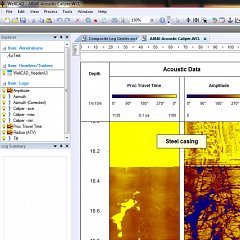QL40-OBI2G-UV
from Mt Sopris
QL40-OBI2G-UV Optical Televiewer with UV Imaging
The QL40-OBI2G-UV probe is an advanced optical televiewer designed to capture both visible light and high-sensitivity UV images of subsurface lithologies and soils within a borehole. It emits 365 nm UV LED light through a sapphire window to induce fluorescence in non-aqueous phase liquids (NAPLs), such as petroleum hydrocarbons.
Key Features:
- Dual Imaging Capability: Simultaneously captures visible and UV-induced fluorescence images at 30 fps for detailed subsurface analysis.
- High-Resolution Imaging: Utilizes a CMOS camera to provide 24-bit RGB true color with 1800 azimuth resolution, delivering precise pixel-by-pixel image capture.
- Advanced Data Collection: When used with the OIP interface, FI6000 instrument, and a laptop, the system collects data on electrical conductivity (EC), penetration rate, fluorescence area (%), and optical power content (%).
Applications:
- Environmental Studies: Detect and map NAPL migration in subsurface materials, enabling horizontal and vertical tracking of petroleum hydrocarbons.
- Hydrogeological and Geological Assessments: Ideal for assessing risks and hazards posed by contaminants.
- Petroleum Research: Proven effective in distinguishing fluorescence variations among different fuels, such as diesel, gas, and crude oil.
- This versatile tool enhances borehole analysis by combining high-resolution optical imaging with UV fluorescence capabilities, making it an invaluable instrument for environmental, geological, and hydrogeological studies.


Operating Conditions
W - Water √
M - Mud
D- Dry √
S - Steel √
P - PVC Borehole √
UC- Uncased √
*Centralization is not required, it can only operate in clear water or dry conditions
Product Dimensions
| Physical | Dimensions (L x W x H) | Weight |
|---|---|---|
| QL40-OBI2G-UV (instrument only) | 1.47 m x x | 5 kg |
Technical Specifications
| UV Wavelength: | 365nm-UVA |
|---|---|
| Image Sensor: | CMOS 1/3 inches Digital Sensor |
| Resolution: | 24 Bit RGB true colour and 1800 pixel azimuthul resolution |
| Precision: | 3 axis accelerometer and magnetometer |
| Optimal Operating Temperature: | 70°C |
Data Sheet
- QL40-OBI2G-UV Datasheet (PDF)





